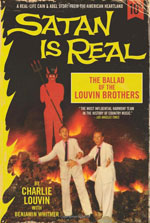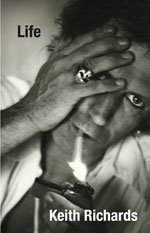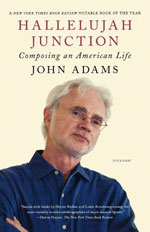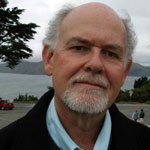TW Review by Fred Setterberg
Lives of Wild Excess and Salvation
 Satan Is Real: The Ballad of the Louvin Brothers by Charlie Louvin with Benjamin Whitmer, HarperCollins, 2012, 320 pp., $22.99.
Satan Is Real: The Ballad of the Louvin Brothers by Charlie Louvin with Benjamin Whitmer, HarperCollins, 2012, 320 pp., $22.99.
Life by Keith Richards with James Fox, Little, Brown, 2010, 576 pp., $29.99.
Hallelujah Junction: Composing an American Life by John Adams, Farrar, Straus and Giroux, 2008, 352 pp., $26.00.
In memoirs by musicians, the devil often shows up early and sticks around. That’s one reason we keep reading, even when the story doesn’t capture the vitality of the music itself.
On page one of Satan Is Real, the saga of the country-and-gospel duo known as the Louvin Brothers, older brother Ira pours himself from the front seat of their touring car, wobbles to his parents’ house in Sand Mountain, Georgia, and drunkenly insults his mama.
By page two, young Charlie has “just kicked his ass all over the place,” thanking God that Papa wasn’t home “or he might have killed” the angel-voiced, mandolin-picking, whiskey-soaked wastrel.
By page three, the Louvins have once again hit the road, with Charlie at the wheel musing about “that day, nineteen years ago, when I saw Roy Acuff driving past the farm in his big air-cooled Franklin.”
Now I was driving down that same road, a Grand Ole Opry star in an automobile almost as nice, and it felt like I was suffocating.
It’s the twinship of excess and regret that we’ve come to expect from the genre. Youthful musicians form a passionate attachment to one style or another. They practice and rehearse with insane dedication, forsaking all other endeavors for the lonesome company of their instrument and their band of brothers. (It’s almost always brothers.) After a string of disappointments, their career catches fire—only to narrowly skirt an annihilating conflagration of good liquor, bad women, and Grand Ole Opry crooning. Or some other incendiary equivalent of sex, drugs, and rock and roll.
The survivors write memoirs. Many of us read them, hoping to experience life as we will never lead it ourselves.
Sure, we may have caught a glimpse of the musical terrain years earlier. As a teenager, I slipped every weekend into my silver-sequined jacket, white ruffled shirt, see-through nylon pimp socks, and imitation alligator-skin slippers along with my own band of brothers. Naturally, we played soul music: bar-band covers of the Temptations, Wilson Pickett, Otis Redding, and enough tunes by James Brown and his Famous Flames to swim, camel walk, and funky chicken our way through a three-hour gig at one of the teen dances so prevalent throughout the San Francisco Bay Area during the mid-'60s.
Several of the guys in our band kept playing for years. A couple never stopped. I set my saxophone aside when I was nineteen and never played seriously again.
What my defection spared me—to judge from most memoirs—was a life of ragged peril born of persistent intemperance somehow attached to, and frequently threatening to overwhelm, the joy of making music.
In Charlie Louvin’s account, the trail of regretful excess winds back to the first song the duo learned as children: “Mary of the Wild Moor,” a ballad about an unmarried, pregnant country girl spurned by her father to die alone in the cold.
It was a “song that had been carried across an ocean by Mama’s people," remembers Charlie, "and passed down to us, just like it had been passed down to her, almost like we were singing with all their ghosts down the generations.” Charlie acknowledges the almost unbearable sadness inscribed in every note and lyric:
I can’t hardly sing it now, because it’s so possible. Because it happened then, and it could still happen now. And nobody should be that cruel, not to a child.
The Louvin Brothers’s ability to absorb life’s sadness and then pitch it back at us in close, heartrending two-part harmony—that’s what fires our deeper interest in their story. The drinking bouts, fistfights, and Ira taking six bullets in the chest and hand from a .22 wielded by his third wife—that’s all honky-tonk neon to attract tourists.
I recognize myself in this rube crowd, glaring goggle-eyed into the bright lights and mayhem. But I also believe that the heart of the musical memoir isn’t located in the soap opera antics of carnal and chemical excess. Rather, we’re ultimately drawn to these books for their naked insistence that music can lead us out of the dark—particularly if we find an instrument to guide us in our youth. As Charlie puts it,
We got the music bug early, and once you get the bug, it’s in your blood. It won’t let you be at ease, it won’t let you relax…. If anybody tries to get you to do anything else, you’re constantly trying to figure out how to get back to it.
 This early and absolute dedication to the art can be found in the least likely of places—say, Keith Richards’s Life.
This early and absolute dedication to the art can be found in the least likely of places—say, Keith Richards’s Life.
Yes, there’s loads of sex and drugs. But the unapologetic and uncannily clear recollections of the rock prince of much-too-much ultimately comes off as…well, restrained. Chastely self-effacing. I’m just a bloke who likes his beer (whiskey, ganja, hash, STP, LSD, Nembutal, Tuinal, coke, heroin). But what I‘m really here to do is play….
It’s not the promise of altered consciousness and random couplings that animates the scrawny young guitar player’s first ambitions. Rather, it’s a glimpse of the transformative power of music. Picture Richards as a feverish fourteen-year-old gripped by the prospect of mounting the stage (once he’s put in his ten thousand hours of woodshedding) to terrify the audience with the depth and ferocity of his sound. It’s that aspiration, gradually realized, that keeps us reading. Music changes lives.
Richards recalls first hearing Elvis’s “Heartbreak Hotel” on Radio Luxembourg:
It was almost as if I’d been waiting for it to happen. When I woke up the next day I was a different guy.
What his memoir and that of the Louvin Brothers conjure up so sweetly is stark, ferocious craving. The desire to be the best blues band in London, the sharpest country duo south of the Mason-Dixon.
Still, for all the pleasures of the well-hewn memoir, I sense a curious absence. The music, the sonic core of each book, takes place almost entirely offstage—or at least, off the page. Too often, we can’t hear what the music sounds like in the author's prose.
Is it any wonder that the finest musicians often can’t wrap words around what they’re up to? Maybe it’s the real devil at the heart of the musical memoir: the difficulty of using words to conjure up the sense and spirit of this most abstract of art forms. Music, the ineffable obsession.
Writing about music is like dancing about architecture. So goes the critical jibe variously attributed to Martin Mull, Elvis Costello, Frank Zappa, Laurie Anderson, Steve Martin, and Miles Davis, among others. The implication is that those of us drawn to music should seize the chance to glory in our release from language: the freedom from meaning, the cool fresh shower of sheer sound.
With all due respect to whoever coined the quip, I think it’s dead wrong. Dance isn’t implicated in the building blocks of architecture. At heart, they’re apples and oranges—or maybe pole beans and pineapples. Words and music, however, share a kinship at the root of human experience. Many linguists and musicologists believe that musical expression evolved alongside the development of speech. The arts of organized sound and expressive language rank as complementary tools for proclaiming our bafflement and exaltation at the mystery of existence. Words and music: They’re how we make sense of the predicament of living and how we transcend it.
If a memoir fails to find the language to conjure up the precise qualities of sound, it can sometimes be traced back to the identity of the writer. Both Satan Is Real and Life are “as told to” recollections deftly handled by professional writers who appropriately render their own sensibilities opaque. It would be presumptuous and downright weird for them to stuff their subjects’ mouths full of words and phrases deliriously redolent of the musical ethers. Which is no knock on Louvin or Richards—or their skilled ghosts. Few musicians write as well as they play, sing, or compose. When they do, it’s worth noticing.
 Take, as a rare example, John Adams, one of our finest contemporary composers—known both for his operas (Nixon in China and Doctor Atomic)and for astonishing orchestral works like Shaker Loops and Short Ride in a Fast Machine. From the opening pages of his memoir, Hallelujah Junction, we’re in the hands of a sensitive observer with an ear acutely tuned to the written word. Here, the devil is in the details, emerging more in the writing than in the author’s antics.
Take, as a rare example, John Adams, one of our finest contemporary composers—known both for his operas (Nixon in China and Doctor Atomic)and for astonishing orchestral works like Shaker Loops and Short Ride in a Fast Machine. From the opening pages of his memoir, Hallelujah Junction, we’re in the hands of a sensitive observer with an ear acutely tuned to the written word. Here, the devil is in the details, emerging more in the writing than in the author’s antics.
For example, Adams describes his first instrument, the clarinet, in terms of its “raunchy, high-register sassiness” and “provocative and licentious squeal.” He’s wonderful in his depiction of his student days, crossing classical training with pop urgency as he and his peers “bored like weevils through the harmonic changes and textural minutiae of albums” by Paul Butterfield, Rahsaan Roland Kirk, Dylan, Cream, Hendrix:
I made more progress in my command of harmonic practice by reproducing these pop songs from memory at the piano than I ever did by my forced marches through the figured bass treatises.
Shrugging off the solemnity of “serious” classical composers, Adams proves himself frank and funny about the Bay Area "new music" scene (also known as "minimalist" or "post-minimalist") of the 1970s:
Concerts, if they could be called that, took place with an air of studied casualness and complete indifference to formality. An audience member might have difficulty telling whether a piece was being performed or whether one had reached intermission—indeed whether the entire event had been canceled without anyone being informed.
Mostly tellingly, Adams acknowledges the influence of both words and music in the formation of his own ambitions:
I had grown up listening to jazz and then later found myself surrounded by the pounding, insistent rhythms and simple harmonic language of rock. That genuinely native music felt to me like my own genome, and I wanted above all to be able musically to intone those roots, just as the great American writers like Whitman, William Carlos Williams, Kerouac, and Ginsberg had found poetry in the speech of the common person.
To be sure, the essence of music has been gloriously revealed in fiction as well as poetry. Think of Toni Morrison’s song-signifying Jazz, the contrapuntal contraptions of Faulkner at his best, and Nick Hornby’s pop tune narratives. Yet I suspect Adams is correct in pointing to the powers of indirection so characteristic of the poem, the most musical of written forms.
Consider Billy Collins’s “The Invention of the Saxophone,” which informs us that when Belgian instrument maker Adolphe Sax introduced his new woodwind to Paris, “it was already 1842, and one gets the feeling/that it was also very late at night.”
Collins knows the instrument well enough to acknowledge its limitations. Gabriel, he notes, will not be blowing sax at the end of the world, since it could only resurrect souls “back into the light of the earth,/but really not farther.”
Best of all, Collins describes the dreamy, other-worldly quality of the saxophone better than anyone I’ve read—even those few word-ready musicians who’ve devoted a lifetime to the mastery of their horn:
For this is not the valved instrument of waking, more the smoky voice of longing and loss, the porpoise cry of the subconscious.
Additional Publishing Information
- The Art of Drowning by Billy Collins (University of Pittsburgh Press, 1995).
Sometimes up on stage, in the middle of a tune like ‘Turn on Your Love Light’ by Bobby Blue Bland—a classic, we’d played it a million times—I’d feel something so strong and certain that it just seemed obvious and impossible to argue about. Then Teddy would spin around on the last chorus at the foot of the stage, look every one of us in the eye—somehow all at once—and we’d be off in another direction entirely. The horns and guitars and organ would cut out altogether to leave the drums working the backbeat, while Teddy started double-clapping on time. Then the rest of the band would start clapping too, and a minute later, everybody in the hall was clapping, and Teddy would be grinning into the blinding light and we’d all be looking into each other’s faces, knowing that this is it. Something truer and purer than anything any of us have ever felt or are ever going to feel again. Three hundred, maybe four hundred pairs of hands clapping double-time on the dance floor at Carpenter’s Hall with nothing but the drums playing, and for a short time that seemed like it was going to last forever: we were standing at the center of the only thing that mattered.
— excerpt from “Jungle Music” in Lunch Bucket Paradise by Fred Setterberg
Fred Setterberg is the author of Lunch Bucket Paradise: A True-Life Novel , published by Heyday (2011), and The Roads Taken: Travels Through America’s Literary Landscapes (Interlink, 1995), which won the AWP Prize in Creative Nonfiction.
A chapter of Fred’s novel, “Escape from Frog Island,” and his essay “What’s a True-Life Novel?” appeared in TW's Jan/Feb 2012 issue.

